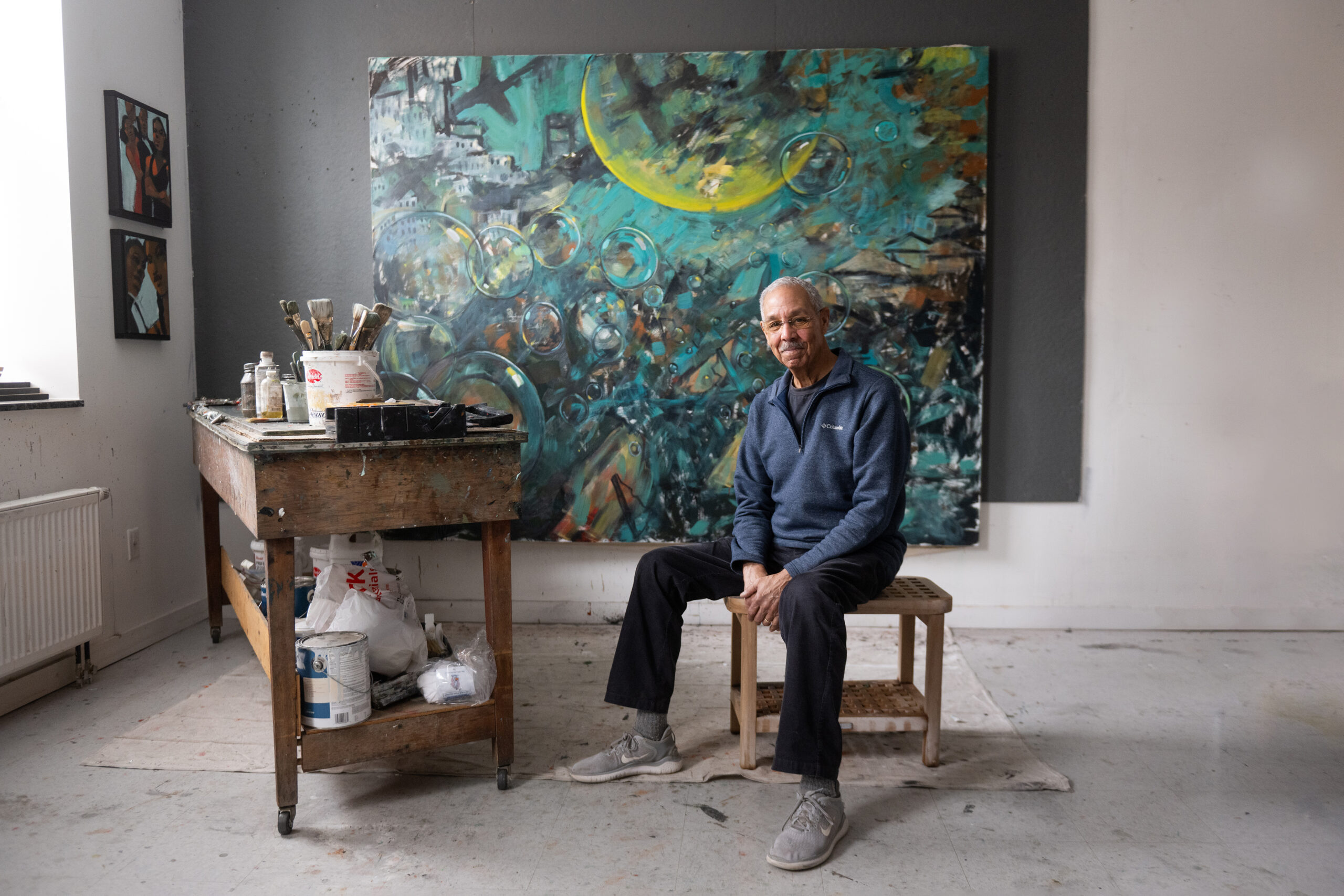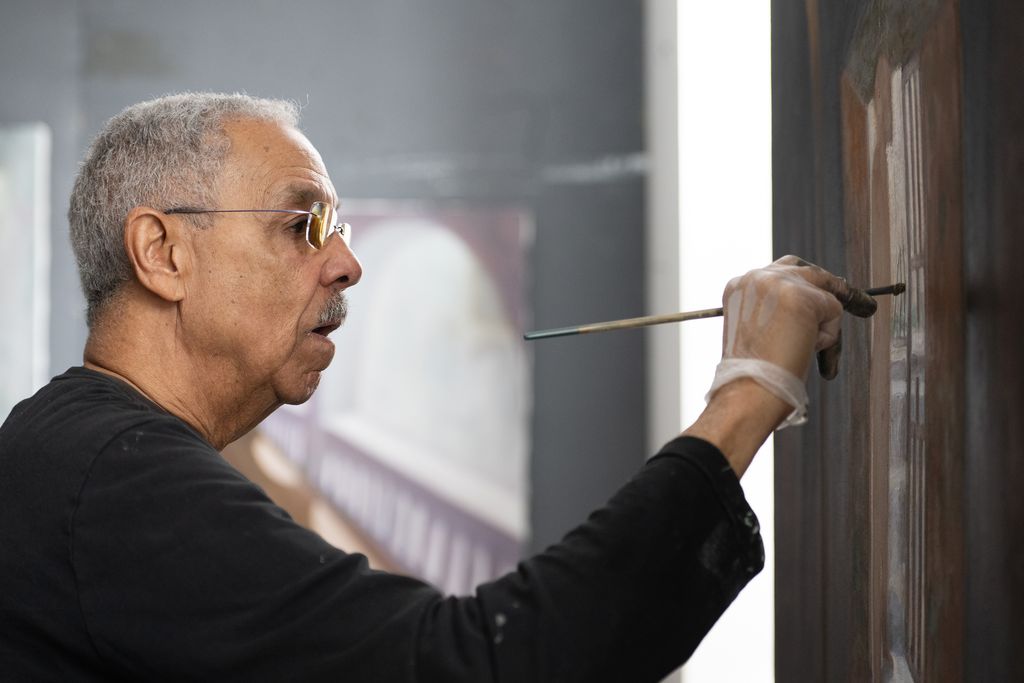A Long Journey Home
Acclaimed painter Robert T. Freeman’s 1981 painting Black Tie hangs inside the Massachusetts governor’s office

Photos by Cydney Scott
A Long Journey Home
Acclaimed artist Robert T. Freeman’s 1981 painting Black Tie hangs inside the Massachusetts governor’s office
In winter 2023, Robert T. Freeman, a Boston figurative oil painter for more than 40 years, got a call from Massachusetts Governor Maura Healey’s office.
“The caller ID said ‘Maura Healey,’ and I thought, I gave them money last month, so I didn’t answer,” Freeman (’71,’81) recalls with a laugh. “But it just kept ringing and ringing and ringing.”
It turns out, Healey herself was on the other end. When Freeman finally picked up, she informed him that his 1981 oil painting Black Tie was one of two works by local artists of color selected to hang in her office.
“I thought, well, that’s wonderful,” he says. “I told her how flabbergasted I was that she would do that.”
Black Tie is displayed alongside Allan Rohan Crite’s At the Tremont Street Car Barns, as part of Healey and Lieutenant Governor Kimberley Driscoll’s initiative to bring “more inclusive faces and voices to the State House,” according to their December announcement.
“When people walk into the governor’s office, I want them to feel seen, represented and empowered,” Healey said in the announcement. “An important way to do this is by hanging artwork that is representative of the diverse Massachusetts experience.”
Freeman’s 4-by-6-foot painting depicts an in medias res scene at an upscale social event in the mid-20th century: a roomful of well-dressed Black guests sit around a table, their heads turned toward the viewer—an interloper—gazing with rarefied remove. Behind them, an orchestra plays and red boutonnieres bloom on the lapels of black tuxedos. According to Freeman, the scene was inspired by a party he and his wife arrived at late—a social faux pas the other partygoers did not appreciate.
In 1981, Black Tie was one of relatively few works that highlighted middle-class Black society, something Freeman became well known for. His Social Season series, with Black Tie the centerpiece, was his own debut to Boston’s arts society. Works in the series are lavished with gold-leaf jewelry, long black dresses, cocktails and cigarettes, mischievous smiles, merriment, hauteur.

Black Tie (1981) Oil on canvas; 48 x 72 in. On loan to the State House, the painting has been in the Art of the Americas permanent collection at the Museum of Fine Arts, Boston, since 2010. © 2024 Museum of Fine Arts, Boston
“We’re a really separate culture here, as middle-class Blacks,” Freeman says.
Beyond his subjects, Freeman’s use of figuration lent him even greater distinction, according to Dana Clancy (’99), director of CFA’s School of Visual Arts and an associate professor of painting.
“Even though [CFA was] teaching figuration, the art world was not doing any—there was a real marginalization for anyone working figuratively in the ’70s,” Clancy says. “Bob Freeman’s work is part of a very important tradition that carries forward into what’s most important right now in contemporary painting, and I think it’s really exciting to have the art world catch up to those same concerns.”
At CFA, Freeman studied under legendary figurative painter Philip Guston (Hon.’70), who taught a graduate seminar from 1973 to 1978. Like Guston’s, Freeman’s paintings prioritize shape, color, and movement over technical precision to achieve a sense of wholeness, reveling in thick, heavy brushstrokes that do more to evoke shared understanding than render reality.
“I never explored my personal subject matter until I started graduate school with Philip Guston,” Freeman says. “He gave me the opportunity to explore what was in my heart and my mind in ways that I had never done before, and it just opened up a world.”
After earning bachelor’s and master’s of fine arts degrees in art education, Freeman took a position as artist in residence at the Noble and Greenough School in Dedham, Mass., where he stayed for 27 years. In 1981, he was itching to show his work in local galleries, but struggled to get his foot in the door.
“I went down to the galleries on Newbury Street first, and…they said, ‘Thank you, but we’re just not interested in that kind of work,’” he remembers. Eventually, he learned that the galleries conducted open calls for art once a month. “So, every month, Bettye [my wife] (CAS’70) would drive a U-Haul and double-park in front of each gallery, and I would slip the paintings out. We did this for over a year. And every gallery said no.”
His fortunes changed in September 1982, when Chapel Gallery in Newton, Mass., exhibited four of his works. A favorable review by Christine Temin, a former staff arts writer for the Boston Globe, and a blown-up image of Black Tie appeared on the front page of the newspaper’s arts section. Temin praised Freeman’s confident handling of the figures and his strong message. That same year, Black Tie was purchased by local philanthropists Newell and Kate Flather (Wheelock’76); in 2010 the Flathers gave the painting to the Museum of Fine Arts, Boston.
Comfortably ensconced in the art world, Freeman was free to explore bolder figuration and more complex subjects. Later series, such as American Regatta, inspired by his love of sailing, display more of the gestural sense of movement and more abstract geometry. America’s Past-Times, a violent jumble of Black and Caucasian limbs engaged in ironic games of tug-of-war, capture the flag, and Marco Polo, moved him away from celebrating Black leisure and toward documenting a more harrowing experience of race in America.
Since the January 6, 2021, insurrection at the US Capitol, Freeman has devoted his artistic attention to the long shadow of slavery and its connection to American white supremacy. During a 2021 trip to Ghana, where he had spent part of his childhood, Freeman visited the country’s notorious slave castles, where, from the 16th through 19th centuries, captives were held before deportation.

“When I returned to the studio, it took the better part of six months to begin figuring out what I was going to do with the pain,” he says. “The narrative was the haunting, empty rooms of the slave castles…. It’s a hard subject matter, but it is something that I think I need to do.”
Freeman had been working on his slave castle series for months when he received Healey’s phone call. After a long journey, Black Tie now hangs in the State House as a vital representation of Black American life.
“The painting has taken off, from me taking it into every gallery on Newbury Street and getting rejected,” he says. “Finally, after 41 years, it’s celebrated—and I couldn’t be happier.”